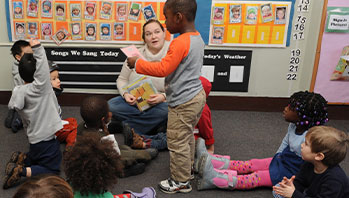- food wall display or Eating the Alphabet book
MA Standards:
Foundational Skills/RF.PK.MA.2.a: With guidance and support, recognize and produce rhyming words (e.g., identify words that rhyme with /cat/ such as /bat/ and /sat/).
Head Start Outcomes:
Literacy Knowledge/Phonological Awareness: Identifies and discriminates between sounds and phonemes in language, such as attention to beginning and ending sounds of words and recognition that different words begin or end with the same sound.
PreK Learning Guidelines:
English Language Arts/Reading and Literature 8: Listen to, identify, and manipulate language sounds to develop auditory discrimination and phonemic awareness.
Word Play: Rhyming Game #1

© Commonwealth of Massachusetts, Department of Early Education and Care (Jennifer Waddell photographer). All rights reserved.
ELA Focus Skills: Phonological Awareness (Rhyme), Vocabulary
Ask children to name some plants they eat. Then invite children to play a rhyming game using different foods.
- Say, I will name a plant food and I want you to name a word that rhymes with it. Demonstrate for children.
- Point to a picture of a bean and say, Bean. Pause as if thinking; then say, Seen. Bean and seen are rhyming words. Have children focus on the ending sounds as you stretch out the sound in each word, be-e-a-a-n-n and se-e-e-e-n-n
- Point to a picture of a lime and say the word. Ask, Can you think of a word that rhymes with lime? (time, dime, climb) Allow time for children to respond. Accept made up words as well as actual words.
- Repeat the process with the words pear (bear, tear, rare); corn (horn, torn, born); fig (big, dig, wig); and pea (me, tree, sea).
Adaptation: With very young children, say two words that rhyme and one that does not (bean, green, lime) and ask children which word does not rhyme.
Adaptation: In groups with varying ages, challenge older children to come up with as many rhyming words as possible in five minutes for the words bean (lean, mean, clean, machine, magazine, seen, teen, thirteen) and pea (bee, he, key, knee, see, me, tea, we).
Educator Tip: Guided and independent Letter, Sound, and Word practice continues to take place in center activities. It is helpful to set up the literacy center immediately after the direct instruction and repeat instruction before children work in the literacy center identifying letters.
